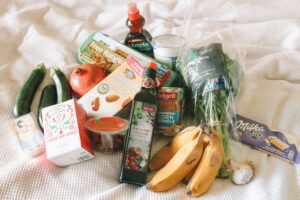

In today’s fast-paced world, convenience foods, take-out meals, and drive-thru’s often dominate our diets. Detoxing from processed and fast foods can be tough, but home cooking offers numerous benefits beyond simply preparing a meal. Here are some of the key advantages:
- Cost savings: Cooking from scratch is often more cost-effective than purchasing pre-made meals or eating out. Buying ingredients in bulk and planning your meals can save money on groceries.
- Reduced Food Waste: With home cooking, you can creatively use leftovers, reducing food waste and saving money.
- Control of Ingredients: Having complete control over the ingredients used allows you to avoid unhealthy additives, preservatives, and excessive amounts of sodium, sugar, and unhealthy fats.
- Nutrient-Dense Meals: Controlling ingredients means you can incorporate a variety of fresh, whole foods into your diet, leading to a more nutrient-dense and balanced meal plan.
- Portion Control: Preparing your own meals allows you to control portion sizes.
- Creativity: Cooking is a form of expression and allows you to experiment with flavors.
Lifestyle Benefits
- Stress Relief: Cooking can be a therapeutic and relaxing activity. Preparing a meal can help reduce stress and improve mental well-being.
- Creativity and Self-Expression: Cooking allows you to experiment with different flavors, techniques, and ingredients, fostering creativity and self-expression.
- Social Connection: Cooking can be a social activity that brings people together and creates lasting memories. Sharing meals with loved ones can strengthen relationships.
- Self-Sufficiency: Learning to cook from scratch equips you with a valuable life skill that can be beneficial in various situations, including emergencies or when living off the grid.


- Essential Cooking Techniques
If you aren’t a cook but understand the importance of improving this essential life skill, here are some fundamental points:
- Knife Skills: Nice to have, but for those transitioning to home-cooked meals, the thought of coming home and chopping ingredients for dinner is already exhausting. It’s one of the reasons many opt for convenience. Small, inexpensive choppers are available that make short work of this. You can also purchase pre-chopped veggies in the store. They’re more expensive but ultimately cheaper than a food-delivery service.
- Sautéing: The quickest way to a home-cooked meal
- Cooking ingredients in a small amount of oil over high heat.
- Perfect for vegetables, meats, and seafood.
- Baking: If you aren’t confident using an oven, try pre-baked items such as bread or pre-cooked meals (make sure they’re not loaded with artificial ingredients) and follow the directions. Use the oven timer to avoid over-cooking and burning. You can also bake a large, tough cut of meat “low and slow” for hours until it’s fork-tender, and it can become several meals. Very little work there!
Braising: Cooking tough cuts of meat in liquid over low heat. Helps to tenderize the meat. If you can purchase a large cut of meat, this is one way to cook it and get great broth too!
- Simmering:
- Cooking food in liquid that is gently bubbling.
- Often used for sauces, stews, and soups.
Soup is not complicated – chopped veggies, potatoes or rice in a broth, and a protein seasoned to your taste. Perfect for the cooler weather…and leftovers you don’t know what to do with! Cooked potatoes can be mashed to thicken soups and stews. You can use bouillon to bring even more flavor, just be mindful of the sodium.
Invest in a slow cooker. Being able to throw a bunch of tasty things into a crock-pot and letting it cook itself is a labor and time saver, plus you can stretch the contents for several meals. Idea: Crock pot-chili! You can also invest in an air-fryer. If you’re finding it hard to get away from fried food, an air-fryer can give you the same results without the guilt, mystery ingredients and expense.
Basic Recipes to Start With
Once you have a solid foundation in these techniques, try your hand at these simple recipes:
- Roasted vegetables: Toss your favorite vegetables with olive oil, salt, and pepper, and roast in the oven at 400 degrees until desired tenderness.
- One bowl meals: Pasta or rice are two quick starches that pair well with just about anything and can go in one bowl. Rice and beans with pork. Pasta with tomato sauce and sausage. Mac and cheese with chopped chicken.
Tips for Success
- Start simple: Begin with easy recipes and gradually increase the complexity.
- Don’t be afraid to experiment: Try new ingredients and flavors.
- Practice makes perfect: The more you cook, the better you’ll become.
- Don’t be discouraged by mistakes: Everyone makes mistakes. Learn from them and keep trying.
Cooking doesn’t have to be complicated. Think about the foods you like, and how you can make homemade versions. Prep meals for the week, so you’re less inclined to hit the fast-food place. Buy pre-cut or pre-seasoned items until you become more confident with prepping and seasoning. Try one new recipe a week, and have the kids help! By mastering basic cooking techniques, you’ll be well on your way to becoming a self-sufficient cook. Enjoy the process and have fun exploring the world of culinary possibilities! Making homemade meals can improve your health, save money, and enhance your overall quality of life.


